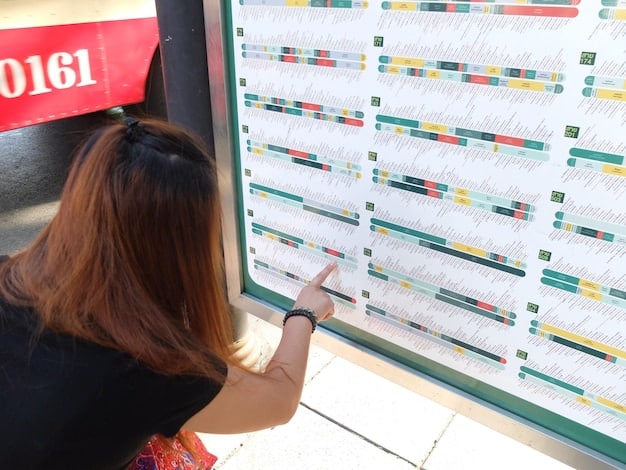K-Pop Comeback Schedules: Predicting US Market Hits

K-Pop idol comeback schedules are crucial for predicting the next big releases in the US market, influenced by label strategies, seasonal trends, and fan engagement analyzed to anticipate album launches and promotional activities.
Predicting the next big K-Pop hit in the US market involves a careful analysis of K-Pop idol comeback schedules. Understanding these schedules offers valuable insights into upcoming releases and promotional strategies.
Understanding K-Pop Comeback Culture
K-Pop comebacks are elaborate and meticulously planned events, differing significantly from typical album releases in the Western music industry. They are a core component of how K-Pop groups maintain relevance and connect with their fanbase. Let’s delve into the key aspects of this unique cultural phenomenon.
The term “comeback” in K-Pop refers to a group or artist releasing new music after a period of inactivity, often accompanied by a comprehensive promotional campaign. This campaign typically includes teaser images, music video releases, and live performances on various music shows. Understanding the intricacies of these campaigns is key to predicting success in the US market.
Elements of a K-Pop Comeback
K-Pop comebacks are multifaceted events, with several elements playing crucial roles in their success. These include:
- Teasers and Concept Photos: These visual elements build anticipation and hint at the theme of the upcoming release.
- Music Video Release: The music video is a central part of the comeback, often featuring elaborate sets, choreography, and visual effects.
- Music Show Performances: Groups perform their new songs on various Korean music shows, providing crucial exposure.
- Promotional Activities: These can include radio appearances, interviews, and variety show appearances, all aimed at maximizing exposure.
The comeback system is strategically designed to keep fans engaged and build excitement. The carefully planned rollout of content ensures that interest remains high throughout the promotional period. This methodical approach significantly influences a group’s ability to gain traction in the US market, where consistent engagement is paramount.

Key Factors Influencing Comeback Schedules
Several key factors influence the timing and frequency of K-Pop idol comeback schedules. These elements can range from internal company strategies to external market conditions. Understanding these influences can provide a clearer picture of when to expect the next big release in the US.
Record label strategies are a significant determinant of comeback timing. Companies like SM Entertainment, YG Entertainment, and JYP Entertainment have established patterns that often dictate when their artists will release new music. Analyzing these patterns can provide valuable insights.
Internal and External Influences
The factors influencing comeback schedules can be categorized into internal and external elements:
- Record Label Strategies: Company-specific patterns and release schedules.
- Artist Readiness: The artist’s creative input and preparation time.
- Seasonal Trends: Releasing music during specific seasons or holidays.
- Competition: Avoiding direct competition with other popular groups.
External factors such as seasonal trends and competitive landscapes also play a crucial role. For instance, many groups release upbeat summer anthems or festive holiday tracks. Simultaneously, labels strategically navigate the schedules of other popular groups to avoid direct competition, maximizing their artists’ chances of success.
Analyzing Historical Data
Examining historical data from previous K-Pop idol comeback schedules provides a valuable foundation for predicting future releases in the US market. By looking at past patterns and timelines, one can identify trends and make more informed predictions.
Analyzing past comeback schedules involves collecting data on release dates, promotional periods, and chart performance. This data can then be used to identify recurring patterns and correlations. For example, some groups may consistently release new music every six months, while others may favor annual comebacks.
How to Analyze Comeback Data
Analyzing historical data involves several important steps:
- Collecting Data: Gathering information on past release dates and promotional activities.
- Identifying Patterns: Looking for recurring timelines and release frequencies.
- Analyzing Performance: Evaluating the chart performance and reception of past releases.
Understanding release patterns and past performance can reveal valuable insights. Groups with consistent release schedules are often easier to predict, while those with more unpredictable schedules may require a deeper dive into other influencing factors. This analysis is critical for accurately forecasting comeback schedules in the US market.

The Role of Social Media and Fan Engagement
Social media and fan engagement have become integral to the success of K-Pop idol comeback schedules, especially in the US market. The ability to effectively leverage these platforms can significantly impact a group’s visibility and overall performance.
Social media platforms like Twitter, Instagram, and TikTok are key tools for promoting comebacks. Groups use these platforms to release teaser content, interact with fans, and generate buzz around their upcoming releases. A well-executed social media strategy can significantly amplify a comeback’s impact.
Strategies for Leveraging Social Media
Effective social media strategies involve:
- Consistent Posting: Regularly updating social media accounts with fresh content.
- Interactive Content: Engaging with fans through polls, Q&A sessions, and contests.
- Hashtag Campaigns: Creating unique hashtags to promote the comeback and encourage fan participation.
Fan engagement is equally crucial. K-Pop fans, known for their dedication and organization, actively participate in promoting their favorite groups through streaming parties, voting campaigns, and social media trends. This collective effort can significantly boost a group’s visibility and chart performance in the US market.
Predictive Models and Algorithms
The use of predictive models and algorithms is becoming increasingly common in forecasting K-Pop idol comeback schedules. These tools leverage data analytics to identify patterns and make informed predictions about future releases.
Predictive models analyze various data points, including historical release dates, social media активности, and market trends, to forecast when a group is likely to make a comeback. Algorithms can identify correlations between these factors and predict future release dates with a degree of accuracy.
Applying Predictive Analytics
Applying predictive analytics involves:
- Data Collection: Gathering comprehensive data on past comebacks and relevant factors.
- Model Development: Creating algorithms that can analyze the data and identify patterns.
- Testing and Refinement: Evaluating the accuracy of the model and making adjustments as needed.
These models are not foolproof, but they can provide valuable insights and help industry analysts and fans make more informed predictions. As the K-Pop industry continues to evolve, the sophistication of these predictive tools will likely increase, making them an even more valuable asset.
Case Studies: Successful Comeback Predictions
Examining case studies of successful K-Pop idol comeback schedules predictions can offer valuable insights into the methodologies and factors that contribute to accurate forecasts. These examples highlight the importance of comprehensive analysis and understanding of industry patterns.
One notable example is the prediction of BTS’s “Dynamite” release. By analyzing their historical release patterns, social media activity, and market conditions, industry analysts were able to accurately forecast the timing of the comeback, which proved to be a major hit in the US. Another successful prediction involved BLACKPINK’s “Kill This Love,” where similar analytical approaches led to accurate forecasting.
Lessons from Successful Predictions
Key takeaways from these case studies include:
- Comprehensive Data Analysis: Gathering and analyzing a wide range of data points.
- Understanding Market Trends: Keeping abreast of current trends and conditions in the US market.
- Recognizing Group-Specific Patterns: Identifying unique release patterns for each group.
These case studies demonstrate that accurate comeback predictions require a combination of data-driven analysis, market awareness, and an understanding of individual group dynamics. By applying these lessons, it is possible to improve the accuracy of future comeback forecasts in the competitive K-Pop landscape.
| Key Element | Brief Description |
|---|---|
| 🗓️ Historical Data | Analyzing past release patterns provides a foundation for predictions. |
| 📱 Social Media | Monitoring activity and engagement gives insights into potential comeback timing. |
| 🎯 Market Trends | Understanding seasonal and competitive factors is crucial. |
| 📈 Predictive Models | Using algorithms for a data-driven approach to forecasting comebacks. |
FAQ
▼
A K-Pop comeback refers to a group or artist releasing new music and initiating extensive promotions after a period of inactivity. It involves teaser releases, music videos, and live performances on music shows to regain attention.
▼
Comeback schedules are crucial to maintaining artist relevance and connecting with fans. They dictate when groups will release new music, allowing fans and industry analysts to prepare for upcoming releases and promotions.
▼
Record labels dictate comeback schedules through strategic planning, considering artist readiness, market dynamics, and seasonal events. They also try to avoid direct competition with other groups to maximize the chances of success.
▼
Social media is vital in K-Pop comebacks. Groups use platforms like Twitter, Instagram, and TikTok to engage with fans, release teaser content, and generate buzz around their upcoming releases. Strong social media presence enhances a comeback’s impact.
▼
Predictive models can offer valuable insights for comeback schedules by analyzing historical release patterns, social media engagement, and market trends. While not foolproof, these models help industry analysts make educated predictions.
Conclusion
Predicting K-Pop idol comeback schedules accurately requires a comprehensive understanding of comeback culture, industry dynamics, and effective use of analytical tools. By monitoring historical release patterns, leveraging social media insights, and staying abreast of market trends, fans and analysts can anticipate and prepare for the next big K-Pop release in the US market.





